| Author |
Message |
Craig Johnson
Industry Professional

|
 Posted: Mon 03 Jun, 2013 8:19 am Post subject: Good work Posted: Mon 03 Jun, 2013 8:19 am Post subject: Good work |
 |
|
| J.D. Crawford wrote: | It also occurred to me that some of the lenticular XVs could have come later than diamond XVs as one attempt to improve cutting in these swords - which, if so, was evidently supplanted by XVIIIs. One would have to take very detailed measurements to figure this out.
Here's one that Craig Johnson sent me, a painting which shows the XV form very clearly:
The Barnabas Altarpiece. c. 1275-1350.
Southwestern France or northern Spain (?)
Kimbell Art Museum, Fort Worth,TX, U.S.A. |
Hi Doug
Good job for finding the source. I must have miss placed it and had been searching but could not find it anywhere. 
I suspect with some detective work we can get a best guess for the date on this peice that might be more refined then that listed.
Best
Craig
|
|
    |
 |
Craig Peters

|
 Posted: Mon 03 Jun, 2013 11:33 pm Post subject: Posted: Mon 03 Jun, 2013 11:33 pm Post subject: |
 |
|
John Fletcher wrote an article about this alterpiece in the Antiquaries Journal. It can be found here: http://journals.cambridge.org/action/displayA...id=7865790. I have included the relevant information, with the key information in bold font.
"The provenance and purpose of the Barnabas Altarpiece, acquired in 1971 by the Kimbell Art Museum and exceptional for being a large early gothic retable on panel, has baffled art historians since 1950, when it became better known; it has since been dated to 1250-60. It was catalogued in 1972 on rather slender grounds as being English (a view that has become increasingly suspect) and it was proposed in 1965 that a bishop Barnabas (at that time not identified) was the donor. The panels are of willow, a wood occasionally used in medieval times for large panels in Mediterranean areas around the Gulf of Lyons, but never in northern Europe or Spain. A priest named Barnabas was made bishop of Osma by King Alphonso of Castile to whom he was physician. He held the see until his death in c. 1351 and founded a chaplaincy in the cathedral in 1350. However, neither that date nor the identification of the panels as willow is consistent with the hypothesis that he was the donor. It is here proposed that the panels were made in the south of France and that the inscription—Barnabas: Eps—applied to St. Barnabas, the apostle born in Cyprus and the first of a long line of archbishops; furthermore that this altarpiece was painted by a southern French artist for a church in Cyprus, probably that dedicated to St. Peter and St. Paul in the royal complex at Nicosia which included the castle/palace and Dominican monastery. It had been the wish of St. Louis, while making preparations in Cyprus in 1248/9 for his crusade, that a new monastic church should form the royal mausoleum for the Lusignan dynasty."
|
|
  |
 |
J.D. Crawford

|
 Posted: Tue 04 Jun, 2013 5:19 am Post subject: Posted: Tue 04 Jun, 2013 5:19 am Post subject: |
 |
|
| Craig Peters wrote: | John Fletcher wrote an article about this alterpiece in the Antiquaries Journal. It can be found here: http://journals.cambridge.org/action/displayA...id=7865790. I have included the relevant information, with the key information in bold font.
"The provenance and purpose of the Barnabas Altarpiece, acquired in 1971 by the Kimbell Art Museum and exceptional for being a large early gothic retable on panel, has baffled art historians since 1950, when it became better known; it has since been dated to 1250-60. |
Nice work Craig! That just might be the clearest evidence for a mid 13th century XV yet.
|
|
   |
 |
Craig Johnson
Industry Professional

|
 Posted: Tue 04 Jun, 2013 5:55 am Post subject: Thank you Craig Posted: Tue 04 Jun, 2013 5:55 am Post subject: Thank you Craig |
 |
|
Excellent! This, I think, is a very solid example that clearly shows the type and with a good date for the art. The quality of the art in depiction and reliability can often be an issue when using it to date types but this is an example of one that we can place high confidence in.
One comment Doug made earlier in the discussion that caught in my brain about the development of types is something Ewart warned me against when discussiong the typology. You do not want to get to stuck into associating the types with a linear time progression. It works in general but it is better to think of them as related sets that can and did evolve in parallel in some cases. Certain types also would fade and come back in popularity so they can add even more complexity to how the sword evolved in form and use.
I think in this alter piece we can firmly date the type XV as being part of the culture by the mid 1200's which is earlier than we would have dated it a decade ago. This also opens the interesting discussion of what is an appropriate amount of time for a type to begin showing up in art. A decade? Twenty years? A few months? All very interesting and fruitfull discussions 
Craig
|
|
    |
 |
J.D. Crawford

|
 Posted: Tue 04 Jun, 2013 10:49 am Post subject: Re: Thank you Craig Posted: Tue 04 Jun, 2013 10:49 am Post subject: Re: Thank you Craig |
 |
|
| Craig Johnson wrote: | I think in this alter piece we can firmly date the type XV as being part of the culture by the mid 1200's which is earlier than we would have dated it a decade ago. This also opens the interesting discussion of what is an appropriate amount of time for a type to begin showing up in art. A decade? Twenty years? A few months? All very interesting and fruitfull discussions  Craig Craig |
Good points CJ.
It seems like weapon design was in really flux around ~1240-1260. On the one hand attempts to make cutters more powerful (XIII), and on the other hand attempts to improve the thrust (XIV, likely XV, maybe even XVI?). And yet they co-exisited with XII and maybe even some old X/XI types for a while. Different tastes, or different tools for different jobs?
Its kind of like cars today. Right now combustion engines dominate with lesser numbers of hybrids and still lesser numbers of pure electric cars. That may change, but if records were lost, archeologists of the future could have a hard time figuring out why different people used these types at the same time.
Anyhow, I'm happy to be convinced that there were XVs in the 13th century. Means I can include them to my collection without feeling like I'm stepping out of period. I still haven't found my 'perfect example', but nice if something more important emerges from that question.
|
|
   |
 |
|
Matthew P. Adams
|
 Posted: Tue 04 Jun, 2013 6:10 pm Post subject: Posted: Tue 04 Jun, 2013 6:10 pm Post subject: |
 |
|
Is there any reason you wouldn't have different swords for different reasons? An XVa with your harness when you're apt to encounter armored opponents and something more cut oriented for a road trip? Assuming you could afford them of course.
"We do not rise to the level of our expectations. We fall to the level of our training" Archilochus, Greek Soldier, Poet, c. 650 BC
|
|
  |
 |
J.D. Crawford

|
 Posted: Tue 04 Jun, 2013 6:52 pm Post subject: Posted: Tue 04 Jun, 2013 6:52 pm Post subject: |
 |
|
| Matthew P. Adams wrote: | | Is there any reason you wouldn't have different swords for different reasons? An XVa with your harness when you're apt to encounter armored opponents and something more cut oriented for a road trip? Assuming you could afford them of course. |
There are descriptions of knights carrying two swords into battle, one presumably a larger warsword and the other an arming sword. For example, Jean de Joinville describes this in his memoirs of St. Louis' 13th century crusades. In one famous anecdote he used the sword mounted on his horse to stab his opponent (Oakeshott speculated that may have been an XV but the description is not clear). In 'Sword in Hand' Oakeshott devotes a whole section about how these were carried (on horse vs. hip).
|
|
   |
 |
J.D. Crawford

|
 Posted: Fri 07 Jun, 2013 8:12 pm Post subject: Posted: Fri 07 Jun, 2013 8:12 pm Post subject: |
 |
|
Here's a direct comparison between one of the swords discussed above (dated by the auction house to 13th century) and a piece I recently purchased from A&A. A&A advertized it as a 15th century XV, but I don't see why it couldn't also represent an earlier type (if the Auction house is correct with their date). Other than some detailing, they look pretty similar. Or is there something about the replica that makes it definitely representative of a later type? What do you think?
 Attachment: 54.93 KB Attachment: 54.93 KB
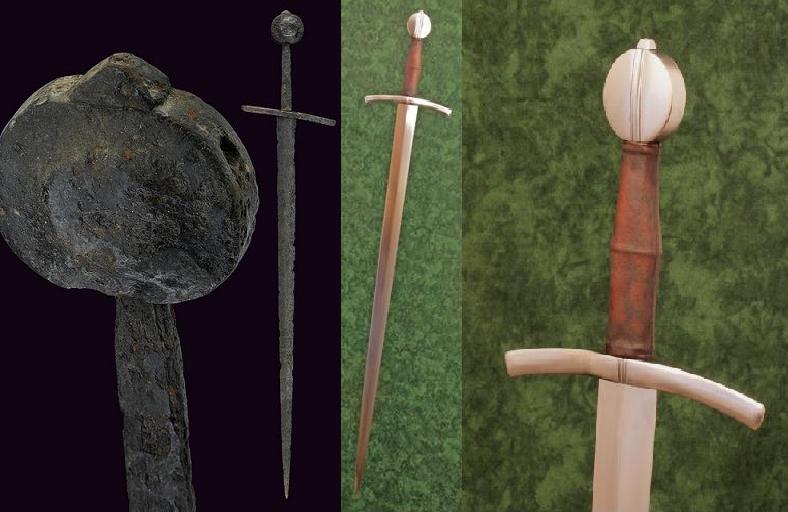
|
|
   |
 |
|
Peter Johnsson
Industry Professional
|
 Posted: Sun 09 Jun, 2013 3:51 am Post subject: Posted: Sun 09 Jun, 2013 3:51 am Post subject: |
 |
|
| J.D. Crawford wrote: | It also occurred to me that some of the lenticular XVs could have come later than diamond XVs as one attempt to improve cutting in these swords - which, if so, was evidently supplanted by XVIIIs. One would have to take very detailed measurements to figure this out.
Here's one that Craig Johnson sent me, a painting which shows the XV form very clearly:
The Barnabas Altarpiece. c. 1275-1350.
Southwestern France or northern Spain (?)
Kimbell Art Museum, Fort Worth,TX, U.S.A. |
Beautiful altarpiece!
Is that sword really a type XV or rather a type XIV? I see the line as marking a narrow fuller, not a ridge as it stops a fair bit short of the point.
|
|
   |
 |
J.D. Crawford

|
 Posted: Sun 09 Jun, 2013 11:20 am Post subject: Posted: Sun 09 Jun, 2013 11:20 am Post subject: |
 |
|
| J.D. Crawford wrote: | | I spent some time looking through manuscript miniatures myself. Its often tough to tell if the artist is trying to depict a narrow fuller or a ridge on a blade, but it is clear that depictions of blades with a triangular profile and pointy tip seem to appear mid 13th century, become more common in late 13th century, and become prevalent through the first half of 14th century. |
| Peter Johnsson wrote: | | Is that sword really a type XV or rather a type XIV? I see the line as marking a narrow fuller, not a ridge as it stops a fair bit short of the point. |
There's the problem again.
To me this example 'looks' like an XV, but its true the line running down the middle of the blade (actually a series of slightly offset vertical lines running with the grain of the material beneath) appears to stop before the end. Did this depict something that stopped, or did the artist feel he had gone far enought to visually depict the desired effect?
Looking across the 'pointy tipped' sword examples in 'manuscript miniatures' one can sometimes see cases where an artist has presumably depicted fullers as a narrowing line with finite thickness. In many cases one just sees a very thin line (that usually does not continue to the tip) - even through 14th century paintings and into 15th century until the art starts to become more detailed and realistic. Those later cases one would tend to assume are XV (or XVa) by their date and type of grip.
Perhaps a professional art historian could figure this out. Its way past my abilities.
There's always doubt when evidence can be interpreted either way depending on which hypothesis one supports.
|
|
   |
 |
Luka Borscak

|
|
  |
 |
J.D. Crawford

|
 Posted: Thu 13 Jun, 2013 5:18 pm Post subject: Posted: Thu 13 Jun, 2013 5:18 pm Post subject: |
 |
|
Here are some more pictures sent by Craig Johnson.
In the first one (dated1225-1249) the shading on the upper blade appears to indicate a diamond shaped cross-section.
In the second (1215-1240) and third (1225-1250) the artist appears to have deliberately left out fullers on some of the swords.
 Attachment: 82.15 KB Attachment: 82.15 KB
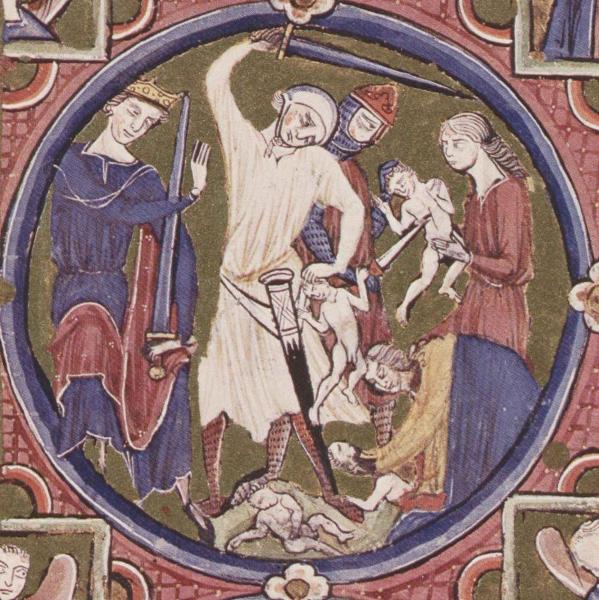
 Attachment: 70.76 KB Attachment: 70.76 KB
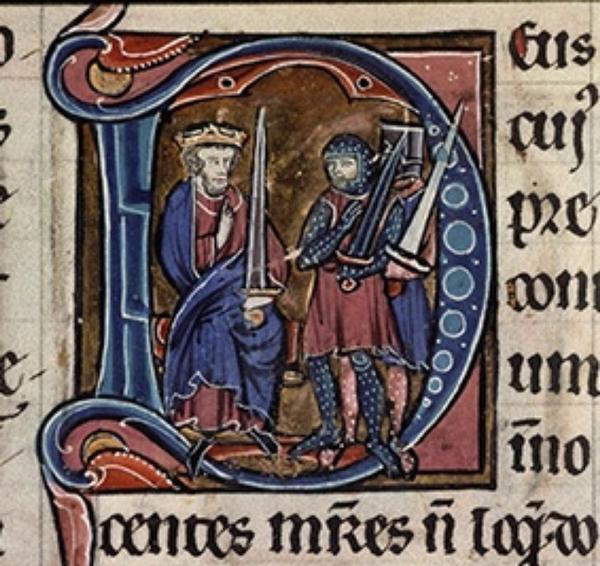
 Attachment: 60.5 KB Attachment: 60.5 KB
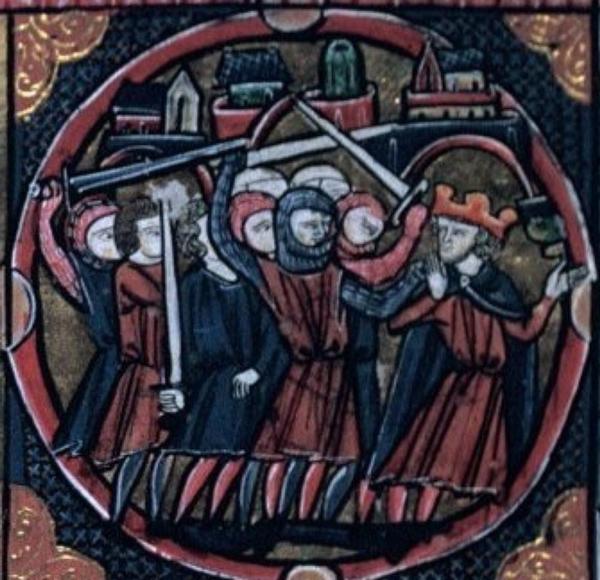
|
|
   |
 |
J.D. Crawford

|
 Posted: Thu 02 Apr, 2015 7:25 pm Post subject: Posted: Thu 02 Apr, 2015 7:25 pm Post subject: |
 |
|
I found these posted here: https://www.pinterest.com/quixoticish/a-historic-arsenal/
Description of the first one (can't vouch for the source material):
"A German Medieval Sword, 14th century. Encrusted with silver (niello), and decorated with cross symbols of copper wire. The blade inlaid with symbols in gold wire. In front, a cross (Teutonic Order of the Knights of the Holy Sepulchre in Jerusalem); the back with an escutcheon. A great example of how colourful things often were in the high and late middle ages. Overall length: 102.7 cm (40.43"); Blade length: 89 cm (35.04")*. Located at Reichsstadtmuseum Rothenburg, Germany."
*This blade length doesn't seem right. The proportions don't work out.
The second one:
"A German Medieval Sword, circa 1300-1350. Disc-shaped pommel. The blade has a brass inlaid mark at the upper section. Hollow-ground blade with pronounced mid-rib. Clearly an anti-armour weapon. Overall length: 109.4 cm (43.1"); Blade length: 92.7 cm (36.5"). Located at Reichsstadtmuseum Rothenburg, Germany."
I wonder if anyone out there has been to this museum and seen these swords? Is there any other literature on them?
 Attachment: 108.04 KB Attachment: 108.04 KB
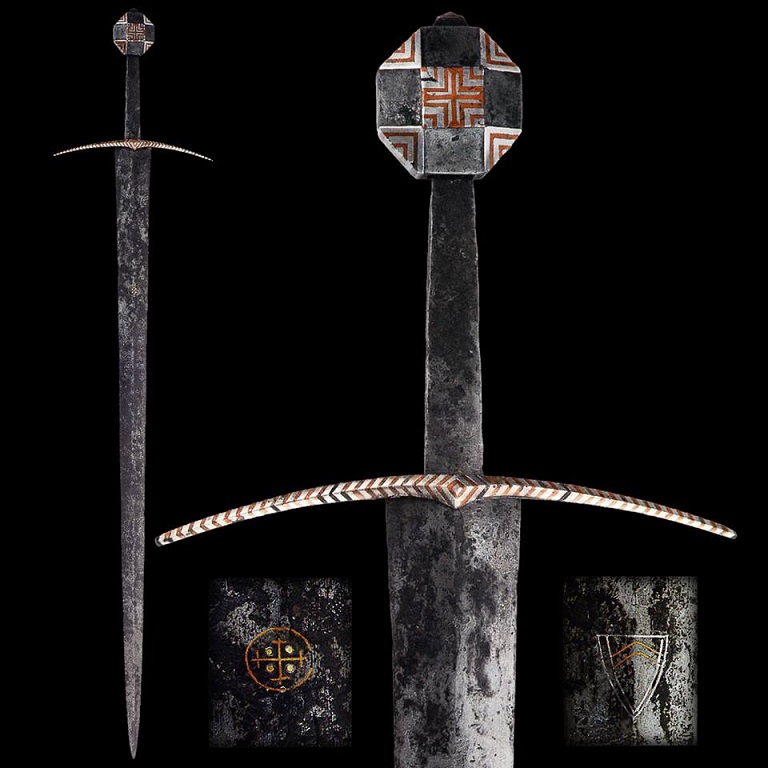
 Attachment: 84.83 KB Attachment: 84.83 KB
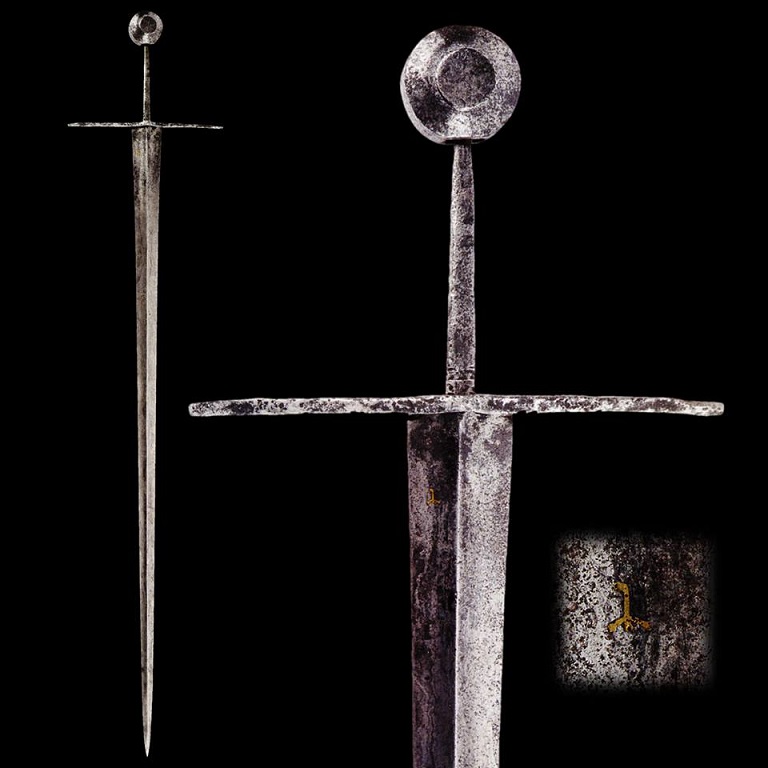
|
|
   |
 |
|
James Moore
|
 Posted: Fri 03 Apr, 2015 4:52 am Post subject: Posted: Fri 03 Apr, 2015 4:52 am Post subject: |
 |
|
from what I've heard, Reichsstadtmuseum Rothenburg has a lot of 19th C. repros in it that aren't listed as such.
Might be wise to get more info about what's in the collection
|
|
  |
 |
|
Mark Lewis
|
 Posted: Fri 03 Apr, 2015 5:58 am Post subject: Posted: Fri 03 Apr, 2015 5:58 am Post subject: |
 |
|
| James Moore wrote: | | from what I've heard, Reichsstadtmuseum Rothenburg has a lot of 19th C. repros in it that aren't listed as such. |
I've heard the same... a few photos from the museum can be found here: https://www.flickr.com/photos/nielsprovos/sets/72157630586189982/
A number of the pieces on display land in the "too good to be true" category to my eyes, but I haven't found solid documentation one way or the other. Would be very interested if anyone does have more detailed information on this museum.
|
|
   |
 |
J.D. Crawford

|
 Posted: Fri 03 Apr, 2015 6:31 am Post subject: Posted: Fri 03 Apr, 2015 6:31 am Post subject: |
 |
|
I also get that 'too good to be true' impression from the 'Teutonic Knight' sword shown above.
The other one with the simple type I pommel looks like a real weapon to my eye, although the blade is long for a single-hand XV. There are a few others nearly that long so its not beyond possibility.
I'd really like to know if that's an authentic medieval sword.
|
|
   |
 |
Craig Peters

|
 Posted: Fri 03 Apr, 2015 11:05 am Post subject: Posted: Fri 03 Apr, 2015 11:05 am Post subject: |
 |
|
| J.D. Crawford wrote: | Here are some more pictures sent by Craig Johnson.
In the first one (dated1225-1249) the shading on the upper blade appears to indicate a diamond shaped cross-section.
In the second (1215-1240) and third (1225-1250) the artist appears to have deliberately left out fullers on some of the swords. |
The thing I would be concerned about is whether these early images are accurate representations or not. For example, Manuscript Miniatures has an image that looks like it might show a Type XV, yet the manuscript is dated to 1150-1199 AD. I am pretty sure most of us can agree that Type XV blades were not in use in the 12th century. So interepreting the images is tricky: is the sword really an XV? Or did the artist simply draw a really triangular blade for what would have been a lenticular blade in real life?
Here's the miniature I refer to: http://manuscriptminiatures.com/4038/11554/
|
|
  |
 |
|
|

